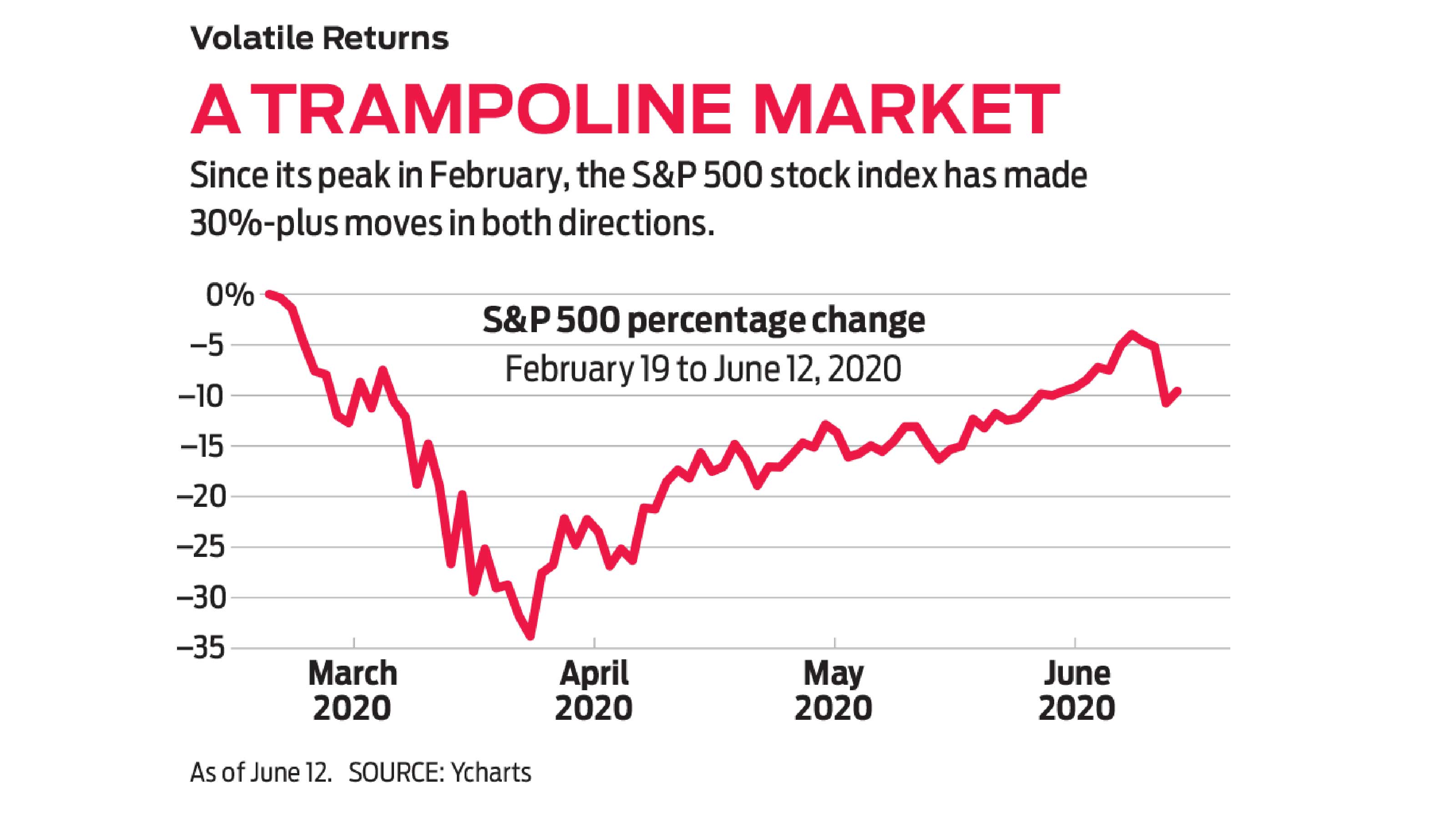Is This a New Bull Market? Or the Same Old Bear?
The rally since March has been historic, but it still needs to prove itself.


Stocks have rallied so sharply in the past few months that it prompts a question: Are we in a new bull market? With the S&P 500 index up 36% since its March 23 low through mid June, the answer seems an obvious yes. And yet, plenty of veteran Wall Streeters say the bull isn’t official yet, and we’ve seen some cracks in the rally.
Conventional wisdom says stocks are in a bull market once they’re up at least 20% from the market’s low. (A bear market is typically thought of as a 20% drop from the high.) But given that bear markets are often punctuated by powerful rallies that ultimately fade, it’s important to add a time element to a bull-market assessment. Sam Stovall, the chief investment strategist at investment research firm CFRA, defines a bull market as a gain of at least 20% plus a span of six months without the market undercutting its prior low.
Official or not, however, Stovall is a bull. CFRA’s 12-month target for the S&P 500 is 3435, 13% higher than its June 12 close. “I think the March 23 low will eventually be regarded as the start of the new bull market,” says Stovall. “The reason for my optimism is the massive amount of stimulus” injected into the market and the economy by the Federal Reserve and Congress. CFRA is most bullish on the communication services, health care and information technology sectors.

Sign up for Kiplinger’s Free E-Newsletters
Profit and prosper with the best of expert advice on investing, taxes, retirement, personal finance and more - straight to your e-mail.
Profit and prosper with the best of expert advice - straight to your e-mail.
Doug Ramsey, chief investment officer and portfolio manager at the Leuthold Group, remains dubious. “The current rally is either the first up-leg of a new bull market or the second-largest bear-market rally in the past 125 years,” he says. On the one hand, you’ve got unprecedented monetary and fiscal stimulus. On the other hand, says Ramsey, price-earnings multiples at the market’s March low remained much higher than in other post-WWII market troughs, making it the priciest bear-market low in history—if it stands. “I still think there’s a chance we could break below those lows,” he says. “I’m trying to look at the glass as half-full, but how can we embark on a multiyear bull market when we’re at valuations that are so much higher than what they were at the same stage of the last bull market?”
A close above the 3386 level for the S&P 500, eclipsing its February high, would settle the question of bull-market status. But investors who wait for that will have missed out on a 50% gain. Conversely, “even if you’re very confident that a new bull market has begun, that doesn’t mean you can’t lose serious money from here,” Ramsey says.

Stay in the game. The debate makes clear that trying to time your investments to coincide with market tops and bottoms is rarely the best strategy. Keeping your portfolio aligned with your age and stage in life, with more-frequent rebalancing in volatile markets, is a better way to reap more-consistent rewards.
It’s also important to remember that even young bulls need an occasional breather. It took only 50 trading days for the S&P 500 to climb nearly 40% from its March low—the biggest 50-day surge since the 1950s, eclipsing the lightning-fast start of the 1982 bull market. That’s a good sign, says senior market strategist Ryan Detrick at investment firm LPL Financial. He says stock prices could be higher this time next year. More immediately, the market looks a little frothy. “We have near-term worries given this historic run,” he says.
Don’t be surprised by more volatility—a hallmark of both the bull and bear aspects of this market. As Detrick reminds us: “There are no roller coasters that can replicate what stocks have done so far in 2020.”
Get Kiplinger Today newsletter — free
Profit and prosper with the best of Kiplinger's advice on investing, taxes, retirement, personal finance and much more. Delivered daily. Enter your email in the box and click Sign Me Up.

Anne Kates Smith brings Wall Street to Main Street, with decades of experience covering investments and personal finance for real people trying to navigate fast-changing markets, preserve financial security or plan for the future. She oversees the magazine's investing coverage, authors Kiplinger’s biannual stock-market outlooks and writes the "Your Mind and Your Money" column, a take on behavioral finance and how investors can get out of their own way. Smith began her journalism career as a writer and columnist for USA Today. Prior to joining Kiplinger, she was a senior editor at U.S. News & World Report and a contributing columnist for TheStreet. Smith is a graduate of St. John's College in Annapolis, Md., the third-oldest college in America.
-
 Stock Market Today: Stocks Soar on China Trade Talk Hopes
Stock Market Today: Stocks Soar on China Trade Talk HopesTreasury Secretary Bessent said current U.S.-China trade relations are unsustainable and signaled hopes for negotiations.
By Karee Venema
-
 2026 Disney Dining Plan Returns: Free Dining for Kids & Resort Benefits
2026 Disney Dining Plan Returns: Free Dining for Kids & Resort BenefitsPlan your 2026 Walt Disney World vacation now. Learn about the returning Disney Dining Plan, how kids aged three to nine eat free, and the exclusive benefits of staying at a Disney Resort hotel.
By Carla Ayers
-
 Fed Leaves Rates Unchanged: What the Experts Are Saying
Fed Leaves Rates Unchanged: What the Experts Are SayingFederal Reserve As widely expected, the Federal Open Market Committee took a 'wait-and-see' approach toward borrowing costs.
By Dan Burrows
-
 Fed Sees Fewer Rate Cuts in 2025: What the Experts Are Saying
Fed Sees Fewer Rate Cuts in 2025: What the Experts Are SayingFederal Reserve The Federal Reserve cut interest rates as expected, but the future path of borrowing costs became more opaque.
By Dan Burrows
-
 Why Is Warren Buffett Selling So Much Stock?
Why Is Warren Buffett Selling So Much Stock?Berkshire Hathaway is dumping equities, hoarding cash and making market participants nervous.
By Dan Burrows
-
 Fed Cuts Rates Again: What the Experts Are Saying
Fed Cuts Rates Again: What the Experts Are SayingFederal Reserve The central bank continued to ease, but a new administration in Washington clouds the outlook for future policy moves.
By Dan Burrows
-
 If You'd Put $1,000 Into Google Stock 20 Years Ago, Here's What You'd Have Today
If You'd Put $1,000 Into Google Stock 20 Years Ago, Here's What You'd Have TodayGoogle parent Alphabet has been a market-beating machine for ages.
By Dan Burrows
-
 Fed Goes Big With First Rate Cut: What the Experts Are Saying
Fed Goes Big With First Rate Cut: What the Experts Are SayingFederal Reserve A slowing labor market prompted the Fed to start with a jumbo-sized reduction to borrowing costs.
By Dan Burrows
-
 Stock Market Today: Stocks Retreat Ahead of Nvidia Earnings
Stock Market Today: Stocks Retreat Ahead of Nvidia EarningsMarkets lost ground on light volume Wednesday as traders keyed on AI bellwether Nvidia earnings after the close.
By Dan Burrows
-
 Stock Market Today: Stocks Edge Higher With Nvidia Earnings in Focus
Stock Market Today: Stocks Edge Higher With Nvidia Earnings in FocusNvidia stock gained ground ahead of tomorrow's after-the-close earnings event, while Super Micro Computer got hit by a short seller report.
By Karee Venema